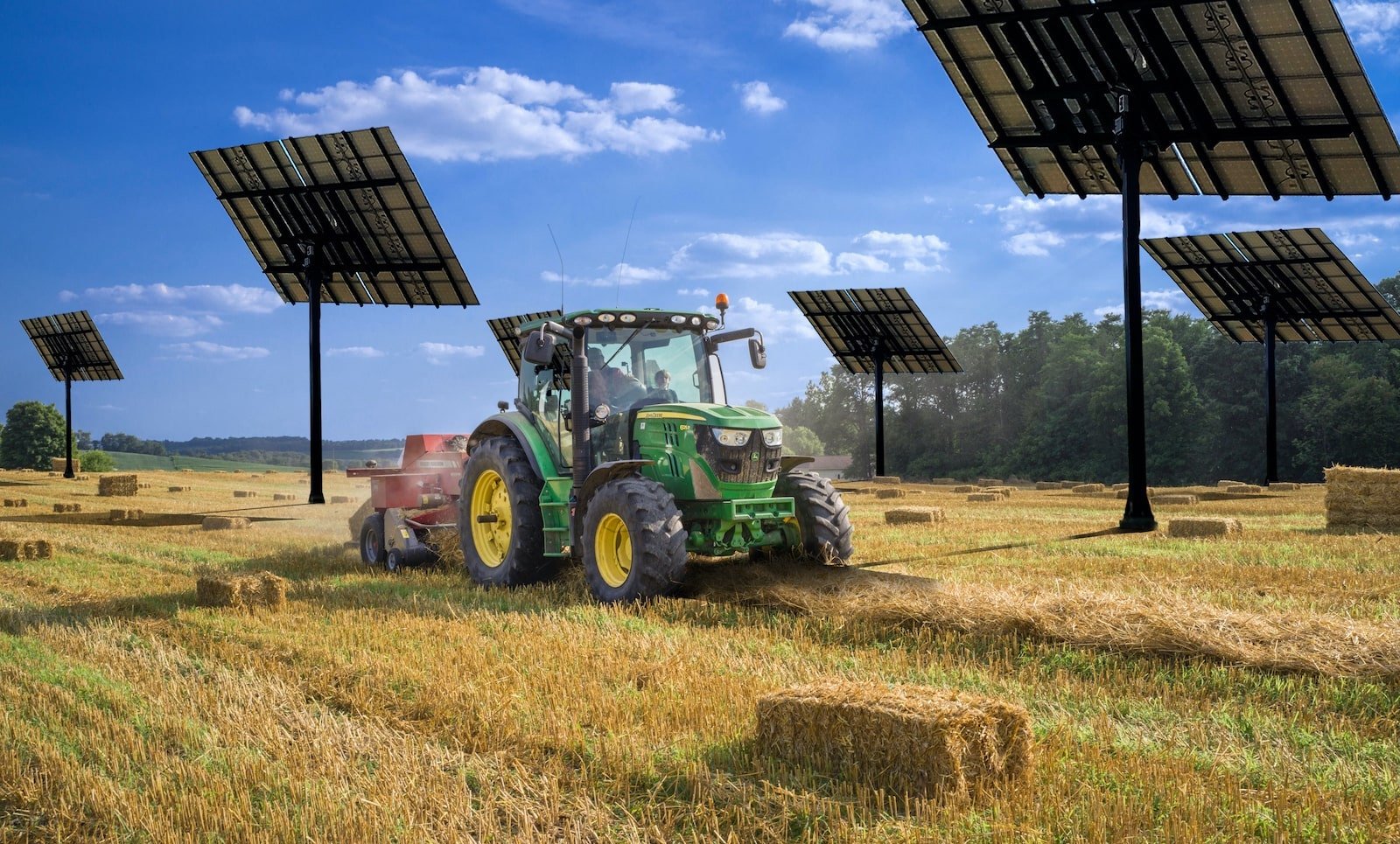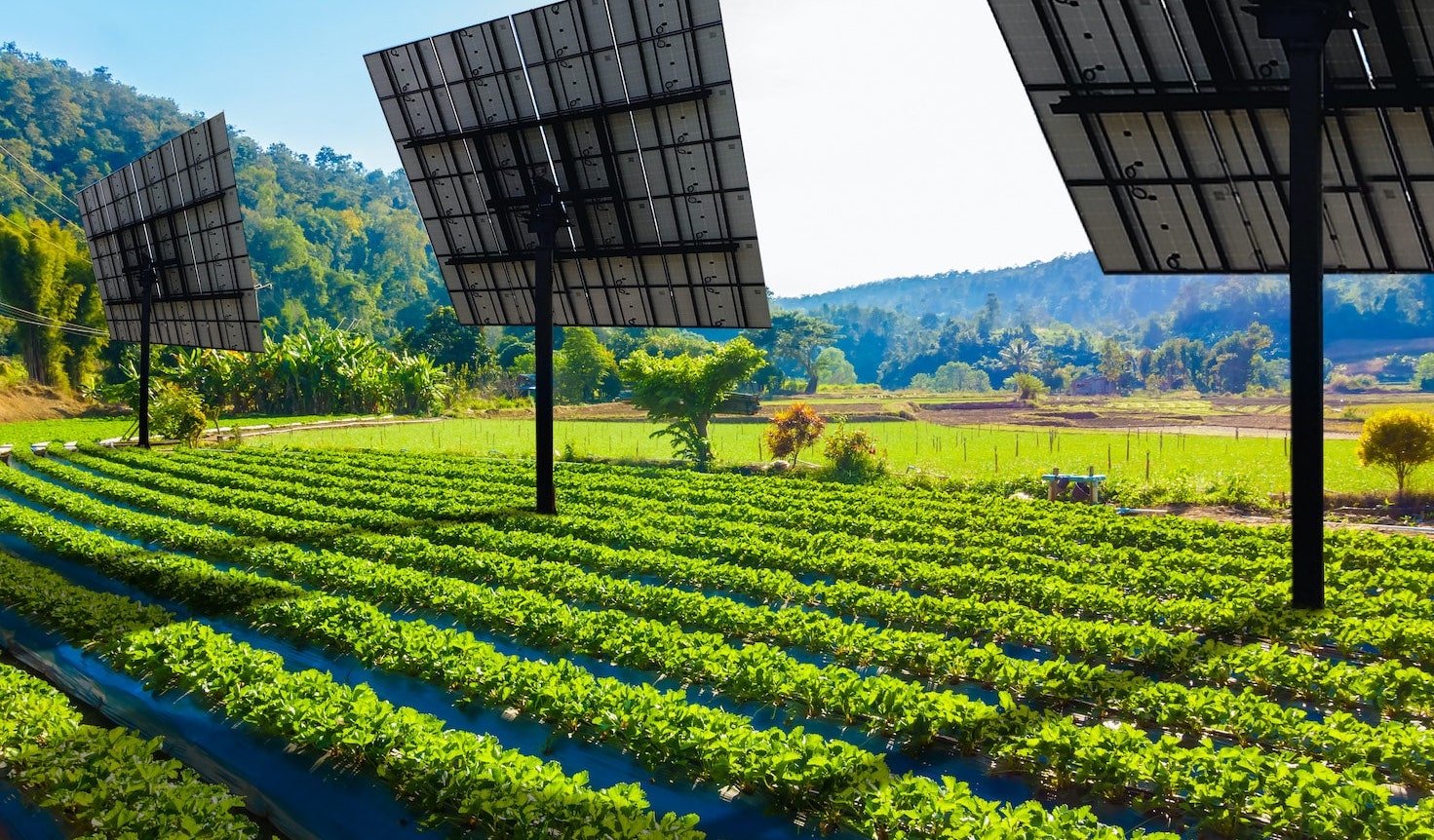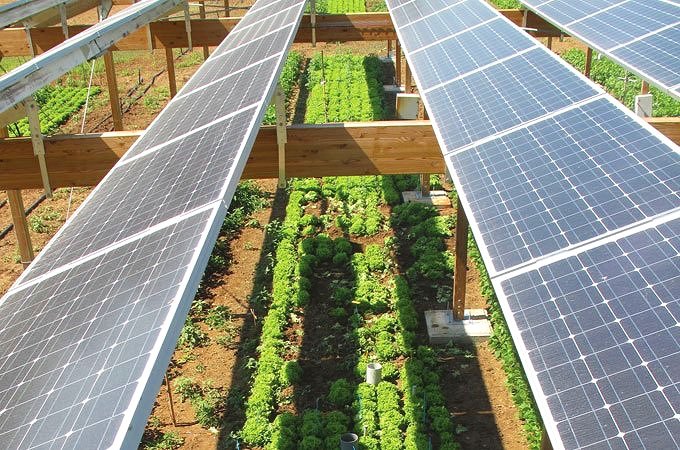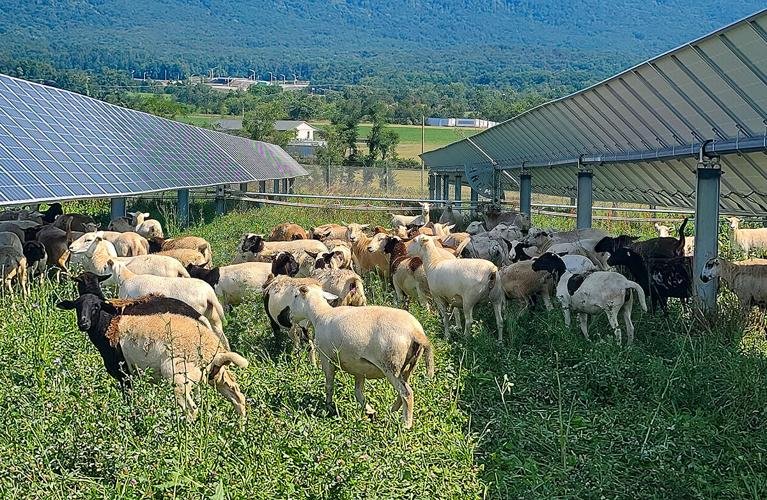Agrivoltaics: The Future of Agriculture with Solar
What is Agrivoltaics?
The term agrivoltaics is a combination of the words agriculture and photovoltaics. It refers to the sharing of agricultural activity and solar panels on the same land. Crops and solar panels share the incoming sunlight so that the landowner benefits from energy generation in addition to agricultural production. And crops benefit, too, when chosen wisely. Plants that need partial shade or just protection from the hottest sun will produce higher yields, will need less water, and will even do better on frosty nights under solar panels. To achieve optimum results, however, the type of solar panel system must be carefully considered and designed.
The term agrivoltaics has been around for less than a decade and is sometimes referred to as agrovoltaics, agrophotovoltaics, agrisolar, agri-PV, dual-use solar, solar sharing, or low-impact solar in various parts of the world. In the United States, however, agrivoltaics is the preferred term, so that is what we will use in the rest of this article.
Types of agrivoltaics
Many scientific studies focus on finding the most efficient way to combine agricultural and solar energy production in the same area.
Agrivoltaic solutions can be grouped into three categories:
Low-mounted solar arrays
These solar panels, typically mounted on 1-3 feet high support structures, are installed in long arrays, between or above crops. They have the advantage of relatively low installation costs, but the disadvantage is that the land under the solar panels has limited access and agricultural use. Only certain low-growing crops (such as lettuce, chard, beets, or spinach) can be cultivated under them, and they require manual cultivation and harvesting. For grazing areas, this solar panel solution is recommended only for smaller animals like sheep, due to its low ground clearance.
Elevated solar structures
Elevated solar panel systems offer a much more versatile and space-saving solution. Although the initial cost is higher than that of low-mounted solar arrays, this additional expense is quickly recouped by maintaining full use of the area underneath for agriculture. They are also well suited to higher-growing crops such as wheat, corn, grapes, and sunflowers. Moreover, the structure can be designed to allow the operation of farm equipment underneath. Livestock can't damage these solar panels either because they rise to a height of 12 to 14 feet, however the support system needs to be sturdy enough to deal with potential impact.
The robust single-pole elevated design and dual-axis rotation of Strackers offer a unique combination of benefits – they are compatible with hilly terrain, they allow easy farm equipment operation, they are sturdy enough for livestock, and they produce the maximum amount of solar power per square foot by following the movement of the sun all day.
Greenhouse solar roof systems
Fixed (i.e., non-tracking) solar panels mounted on the roof of greenhouses are generally the least efficient of all agrivoltaic solar solutions and have a markedly negative impact on yields compared to the above options. A scientific experiment found that when half the greenhouse roof was covered with conventional solar panels, crop output was reduced by 64% and panel productivity was 84% lower.
Truly efficient greenhouse solar systems use semi-transparent solar panels that allow some of the sun's rays to pass through to the crops. Most of these modules are still new developments or experimental, so research on their efficiency, yields, and return on investment should be taken with a grain of salt. If you are looking to install solar panels over your greenhouses, you may come across new solar technologies such as crystalline or amorphous, cadmium telluride, perovskite, and dye-sensitized panels. Of course, you can use these panels for almost any other mounting system, not just for fixed solar panel systems over greenhouses. However, the price of these panels can make the initial cost of an agrivoltaic solar system considerably higher, extending the time to profitability. So, it is best to do thorough calculations of efficiency and ROI before investing in such panels. However, you should keep an eye on the evolution of the technology because what might not be outright profitable today may give your farm the competitive edge you need to stay ahead of the competition in a few years or a decade.
Why build your agrivoltaics farm using Strackers?
If you are considering using some of your farmland for solar energy production, you most likely are interested in profitability and clean energy. But, at what expense? Most solar installations greatly compromise land use and accessibility - either with low ground-mounted panel systems or intricate support structures that raise panels enough to allow manual crop cultivation and harvest. Neither are ideal for mechanized operations.
The Stracker elevated dual-axis solar trackers were developed specifically for dual-use sites.
We had two primary goals in mind when designing the Stracker solar panel system:
Produce as much energy as possible per solar panel
This requires not only using the most efficient solar panels but also pointing them at the sun as accurately as possible during the day, 365 days of the year. Today, this is best achieved with dual-axis solar trackers, of which Strackers represent the cutting-edge solution. These trackers precisely track both the east-west and north-south movement of the sun, so solar panels can always be precisely at a right angle to the incoming rays, collecting maximum solar energy. This design can produce up to 70 percent more solar power than traditional fixed, non-tracking solar panels, found on other type of agrivoltaic solutions.
Maintain full use of the ground below
It takes fewer solar panels mounted on Stracker's high-efficiency solar trackers than on fixed structures to meet the energy needs of a farm.
But that is not all.
Because the solar panels in the Stracker dual-axis system are elevated on a single 20 ft pole, they don't get in the way of tall crops, livestock, or machinery. Strackers take up very little space on the ground: the base of the mounting structure requires only a few square feet of land – and every unit carries 28 bifacial solar panels.
Is agrivoltaics worth it? Let’s talk numbers
When considering the installation of an agrivoltaic solar solution, the most important issue is the distribution of the available land and sunlight between the solar panels and the crops. We have already explained how an elevated solar power system allows you to keep on farming below the panels, i.e., to use the land for two purposes at the same time. The only question is what trade-offs and loss of yield (if any) you can expect in the area under the solar panels.
This point has been the subject of much academic research in recent years and results indicate that the advantages of agrivoltaics outweigh its disadvantages even with crops that need full sun, and with certain crops, yields are even higher under solar panels.
A major study in 2019 led by the University of Arizona published impressive data on the agrivoltaic options tested:
Energy production of the solar panels increased by 2% because evaporation from crops planted under the solar panels cooled the hot air trapped under the solar structure, keeping the panels 16°F cooler. Since the efficiency of solar panels drops significantly when their temperature rises above a certain level, this cooling effect had a beneficial effect on energy production.
Crops grown under solar panels were 2-4 times more productive.
Thanks to the solar panels, soil moisture remained approximately 15% higher, and irrigation efficiency improved significantly: by 65% for cherry tomatoes (while fruit production doubled!) and by 157% for jalapeño.
Another study found that combining solar energy generation with shade-tolerant crop production increased the economic value of farmland by more than 30%. If all the lettuce-producing farmland in the United States were converted to an agrivoltaic system, 40-70 GW more solar energy could be generated.
Researchers at Oregon State University have calculated that combining solar PV systems with agricultural production could solve 20% of our energy needs in the United States.
Researchers at the Fraunhofer Institute for Solar Energy Systems have found that agrivoltaic systems have increased farmland productivity by 60% even with wheat. Although in the combined agrivoltaic structure both wheat and solar panels delivered a reduced efficiency of about 80%, together they showed a 160% productivity compared to when the land was either used for wheat production or solar energy generation only.
It is important to note that these studies have typically involved basic fixed solar panel systems rather than solar trackers. With elevated dual-axis solar trackers such as Strackers, landowners can achieve even greater combined productivity.
Environmental impacts of agrivoltaics
The case for the rapid introduction of agrivoltaics is not only based on economic considerations, but also sustainability. According to the cited study from Oregon State University, the widespread deployment of agrivoltaic systems could reduce carbon dioxide emissions in the United States by 330,000 metric tons every year. That's equivalent to 75,000 fewer gasoline-powered cars on the roads. Furthermore, these sustainable solar panel installations would also create an estimated 100,000 new rural jobs.
For farmers, sustainable farming and carbon footprint reduction are vital. Rapid climate change is posing an increasing challenge, as the need to mitigate drought and rising average temperatures requires ever greater investments. If farmland owners adopt agrivoltaic solar panel systems, it could significantly reduce the need for fossil fuels, not to mention set a good example for businesses in other industries.
As the study concludes, “agrivoltaics provide a rare chance for true synergy: more food, more energy, lower water demand, lower carbon emissions, and more prosperous rural communities.”
What kind of crops are best suited for agrivoltaics?
Research has consistently shown that it is better for solar power systems to have vegetation underneath than to make the ground barren. If the area under the system is covered with gravel or sprayed with herbicides to eliminate grass and weeds, a heat island effect is created where the reflected heat from the soil or rocky surface makes the solar panels hotter and less efficient than optimal. However, if crops are planted or grass grows under the solar power system, they absorb some of the sunlight while also evaporate water, which cools the solar panels.
Most research has found that vegetables that benefit from partial shade such as lettuce, spinach, potatoes, beets, and carrots are the most efficient crops to grow in an agrivoltaic solar system. In experiments conducted in the Sonoran Desert, tomatoes, chard, kale, cabbage, and onions all performed well.
Leafy greens thrive particularly well in an agrivoltaic symbiosis, as the shade provided by the solar panels protects them from the scorching sun, while also boosting leaf growth so the plant can make the most of the limited amount of sunlight.
In Oregon, pasture grasses and barley have performed exceptionally well, but local researchers believe that a variety of berries can also produce good yields while maximizing energy production.
Some crops specifically increase yields when planted under solar panels and even require less irrigation. For example, salsa ingredients (cilantro, peppers, and tomatoes) need only half of the water in an agrivoltaic environment.
Low-mounted solar arrays would not work for tall crops like wheat or sunflower, but with elevated solar trackers like Strackers, even those can be cultivated efficiently.
Can solar panels coexist with livestock?
Ground-mounted solar power systems can be used together with more than just crops. Another important branch of agrivoltaics is solar grazing. Solar grazing refers to the grazing of livestock under and around solar panels.
Smaller livestock such as goats and sheep go very well with even low-mounted solar panel systems. Solar grazing with sheep is an almost perfect symbiosis: the solar panels provide shade for the grass growing under them, the grass evaporates moisture to cool the solar panels, increasing their efficiency on hot summer days, and the sheep take over the role of heavy machinery in maintaining the grass, creating a more sustainable and eco-friendly operation. This agrivoltaic approach is so popular that sheep farmers have their own agrivoltaic organization: the American Solar Grazing Association, where members "are developing best practices that support shepherds and solar developers to both effectively manage solar installations and create new agribusiness profits."
However, when larger animals are kept in an agrivoltaic environment, the support structure of the solar panel system must be custom-designed and reinforced. Cattle weighing more than 1,000 pounds can cause serious damage to a conventional solar panel pole when leaning against it to scratch itself. Therefore, these poles should be made of stronger material, dug deeper into the ground, and carefully secured. While this may somewhat increase installation costs, various farms across the country have found that it is still worth the investment.
With Stracker Solar’s single-pole elevated solar trackers no customization or reinforcement is necessary. The robust Stracker offers a 14-foot ground clearance even when the solar array is in its most vertical position, and the 12-inch structural steel pole with its solid concrete foundation can deal with natural animal activity.
Researchers at Michigan Technological University and The University of Western Ontario have studied the environmental impact of another pasture-based agrivoltaic concept: co-farming rabbits and solar. They show that "the pasture-based agrivoltaic system features a dual synergy that consequently produces 69.3% less emissions and demands 82.9% less fossil energy compared to non-integrated production."
To conclude, solar panels and livestock are not only able to coexist, but together they represent a highly economic and environment-friendly agrivoltaic solution.
Better pollination with agrivoltaics
Agrivoltaic systems are not only suitable for crop cultivation and grazing, but you can also create an excellent pollination area under them.
Minnesota, North Carolina, Maryland, Vermont, Virginia, and several other states are encouraging the adoption of agrivoltaics.
Research at Oregon State University reported that the shade provided by solar panels increased the number of wildflowers and extended the blooming period. Flowers under solar panels attract bees, which has a positive effect on the surrounding ecosystem. Pollination is a significant aspect of agricultural production: 75% of flowering plants and 35% of crop species require pollinating insects for reproduction. Pollination is also a thriving business; in the United States, it is valued at about $14 billion.
Promising research results and the future of agrivoltaics
The importance of agrivoltaics is best illustrated by the U.S. Department of Energy's major program to promote the compatibility of solar PV systems with agricultural activity. The program is called InSPIRE (Innovative Solar Practices Integrated with Rural Economies and Ecosystems) and has a wide range of goals from co-locating solar projects on agricultural lands for mutual benefits to investigating low-impact site preparation practices for ground-mounted solar projects.
In their Solar Futures Study report, they envision that 40% of the nation's electricity will be solar generated by 2035, which will require the involvement of farmlands.
Agrivoltaics is also at the forefront of independent academic research. In addition to the aforementioned studies in the Sonoran Desert and Oregon, various agrivoltaic systems are being tested across the country, and researchers are investigating the effects of several variables on both crop yields and energy production, as well as environmental impacts.
Climate change also makes the development of agrivoltaic systems a matter of urgency: farmers are among the first to experience the economic impacts of global warming. By deploying an agrivoltaic system, landowners can contribute to sustainable farming, reduce their own energy costs and energy dependency, and diversify their business profits by selling the energy surplus to the grid or into community solar projects.
Agrivoltaics is exploding in popularity. In 8 years, the energy production of agrivoltaic farms has increased from 8MW to 2.9GW. The National Renewable Energy Laboratory estimates that by covering 1 million acres of farmland with solar panels, we could meet the country's renewable energy targets.
And if we used dual-axis trackers such as Strackers instead of conventional fixed or single-axis solar panel systems, a much smaller area would be needed to meet this ambitious goal.









